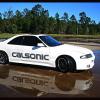Boost Controller Troubles
Announcements
-
Similar Content
-
Latest Posts
-
Well, in the same way that you can't tell any SUV from any manufacturer in any size category from any other one, "sports" coupes now all look identical. Stand back and squint your eyes and the Supra and the 400Z and the GR/BRZ things all look the same. I was just thinking last night, when sitting behind a Subaru CrossTrek, that I have no idea what it is, how it differs from an XV, or a Forester, or an Outback, or anything else Subaru offer, and I couldn't tell if it was supposed to be small, medium or large. I contrasted that to the good old days, where a HQ Kingswood had familial similarities to an LJ Torana, but there is no way that you could confuse them, and how a bit later, the HX Kinger and the concurrent Torana and the Gemini all had familial similarities, but you still could not confuse them. Ditto the ugly Fords and Chryslers of the era. But now, a RAV4 looks like a Kluger, looks like a Yaris/Cross/whatever they're calling those stupid f**king things, looks like every other Toyota that's not a Camry/Corolla sedan.
-
The Prelude doesn't look that bad without all that lens distortion in those pics. Makes it look disproportionate when it isn't. Actually I kind of liked it at the Osaka Auto Messe earlier this year.
-
By Dose Pipe Sutututu · Posted
Pour in the highest octane, non-ethanol fuel you can get and see if the readout changes. If it's dead bang on 11% then I would question the sensor. Another quick test, just take it out and run normal (in an american accent) gas-o-line through it and see if the sampled ethanol or lack of changes. United E85 here in the land of drop bears does vary a bit, I've had as high as E87 (could be water in their tanks too, who knows) -
Yep. And if you ever do, you'll just have to deal with it then.
-
By joshuaho96 · Posted
E10 is pretty tightly regulated in percentage. Too much and engines can't adapt. Every incentive is against them to have too little ethanol though. The more ethanol the higher the octane.
-








Recommended Posts
Create an account or sign in to comment
You need to be a member in order to leave a comment
Create an account
Sign up for a new account in our community. It's easy!
Register a new accountSign in
Already have an account? Sign in here.
Sign In Now